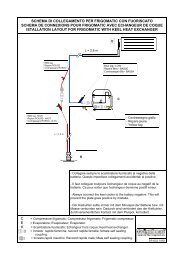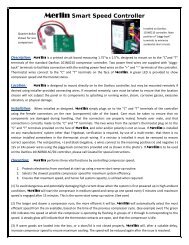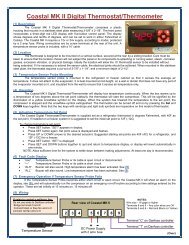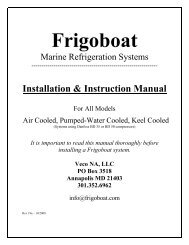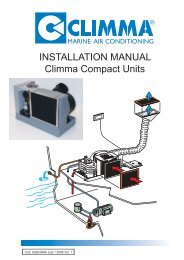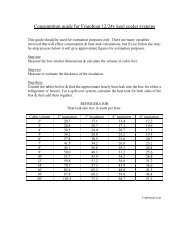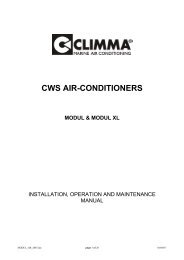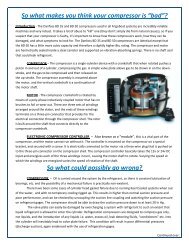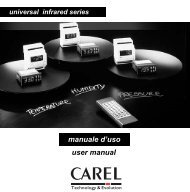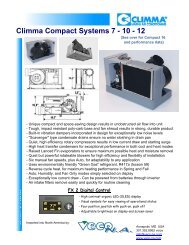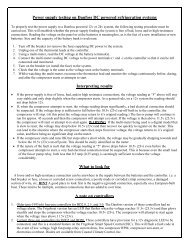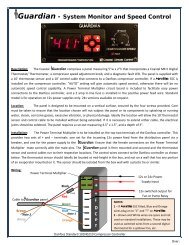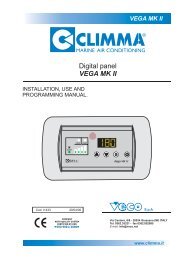GET THE COLD FACTS - Veco NA
GET THE COLD FACTS - Veco NA
GET THE COLD FACTS - Veco NA
Create successful ePaper yourself
Turn your PDF publications into a flip-book with our unique Google optimized e-Paper software.
Which Thermostat?<br />
A thermostat senses the temperature of the evaporator plate or the air inside<br />
the box and tells the compressor when to turn on and off. Two types are<br />
available from Frigoboat. Both are designed to keep box temperatures within<br />
Why Vary The Compressor Speed?<br />
The Danfoss compressors that Frigoboat uses have variable speed capability.<br />
The slower the compressor runs, the more efficient it is, and the faster it runs<br />
the more cooling power it delivers. So ideally the compressor should run<br />
You’ll Find Frigoboat<br />
On The Coolest Boats<br />
In The World.<br />
<strong>GET</strong> <strong>THE</strong> <strong>COLD</strong> <strong>FACTS</strong><br />
ON MARINE REFRIGERATION<br />
2 degrees Fahrenheit of the set point.<br />
at the fastest speed initially to cool the box down and then run as slow as<br />
Mechanical Refrigerator Thermostat<br />
Carel Digital Thermostat<br />
Coastal Digital Thermostat<br />
Mechanical Thermostat<br />
Mechanical Thermostats operate on the<br />
principle that gas in a sealed tube expands<br />
and contracts with temperature. One end of<br />
the tube is attached to the evaporator, and<br />
the pressure expands or contracts bellows<br />
within the thermostat, which act on a switch<br />
to open or close the thermostat. The setting<br />
is made on a knob graduated 0 through<br />
7. The Mechanical Thermostat must be<br />
mounted at a location within the scope of the<br />
tube, which is 5’ long. This tube cannot be<br />
lengthened or shortened, dictating that the<br />
thermostat must usually be mounted within<br />
the box itself, which is typically a humid<br />
environment. Consequently, Mechanical<br />
Thermostats have a short life span. They<br />
are designated as either Refrigerator (white<br />
housing), or Freezer (blue housing). When<br />
using a B or H evaporator, the Refrigerator<br />
Thermostat is used.<br />
Digital Thermostat/<br />
Thermometer<br />
The Digital units utilize a sensor mounted<br />
within the box where it picks up average air<br />
temperature and sends it to a remote digital<br />
display. The display and keypad allow the<br />
user to monitor box temperatures as well as<br />
set the desired box temperature and range<br />
(differential). Very accurate and steady<br />
temperatures can be achieved without the<br />
guesswork associated with Mechanical<br />
Thermostats. The digital read-out of box<br />
temperature is a convenient and popular<br />
feature.<br />
Two versions are available; the “Carel” and<br />
the “Coastal”, and both models have the<br />
same size display and keypad, with the<br />
Coastal being the lowest cost but with fewer<br />
features. For most installations the Coastal<br />
represents very good value for money, as the<br />
extra features found on the Carel are rarely<br />
accessed. Both models require a dedicated<br />
12v or 24v power supply and are supplied<br />
together with sensors (10’ for the Coastal,<br />
20’ for the Carel), and a stainless steel bezel<br />
to aid mounting into a vertical bulkhead.<br />
possible to maintain temperatures. There should be a provision for the speed<br />
to be adjusted manually or automatically when warm goods are put in the<br />
box and/or when external conditions change. In addition, the highest load<br />
on the electronics (and highest risk of failure) happens during the first few<br />
minutes of start-up with the compressor running at maximum speed. As a<br />
safeguard, the compressor should be started in a slower speed, where there is<br />
less strain on the electronics, and then gradually increased to maximum.<br />
Do I need a speed control?<br />
No, you don’t need it, but it makes the system far more efficient as well as providing muchneeded<br />
protection for the electronics. NOTE: Pumped-water cooled systems and those using<br />
holding plates should be set to run only at maximum speed.<br />
What are the options?<br />
1. Fixed speed: Speed set at lowest speed (2000 RPM). Non-adjustable. Standard on<br />
Frigoboat’s smallest capacity systems.<br />
2. Variable speed, manually adjusted: User-adjustable speed selection from 2000 RPM to<br />
3500 RPM. Standard on most Frigoboat systems.<br />
3. AEO (Adaptive Energy Optimization): Speed adjusted automatically to achieve 30-minute<br />
compressor run time. Ramp start from mid-speed on start-up for electronic protection.<br />
No remote panel. Option on all Frigoboat Systems.<br />
4. SSC (Smart Speed Control): Speed adjusted automatically to achieve longer run times<br />
than with AEO and hence more efficiency. Manual over-ride and speed selection available.<br />
Remote panel shows speed<br />
that compressor is set to from<br />
the six available, and whether<br />
Hylas<br />
Island Packet<br />
Caliber<br />
Royal Passport<br />
Saga<br />
Kanter<br />
Lyman Morse<br />
Zimmerman<br />
Tayana<br />
Pearson–<br />
True North<br />
Selene Trawlers<br />
Maine Cat<br />
Azimut Benetti<br />
Outbound Yachts<br />
Cherubini<br />
Hans Christian<br />
Corsair<br />
Hanse Yachts<br />
Catman Cats<br />
Steve Dashew<br />
Nigel Calder<br />
Bristol Channel<br />
Cutter<br />
Catalina<br />
Promarine<br />
Malo<br />
Amel<br />
Catana<br />
Dufour<br />
Grand Soleil<br />
Lagoon<br />
Jongert<br />
Wauquiez<br />
Privilege<br />
Palmer Johnson<br />
Frigoboat marine refrigeration systems are the most dependable, quiet and efficient<br />
systems for keeping your perishables fresh and your beverages cold. Here is your<br />
guide to choosing the very best refrigeration components for your boat.<br />
compressor is running or<br />
“Our production and sales team love your<br />
system and found it to be user friendly and an<br />
absolute winner. From all the Catalina team<br />
here, ‘Thanks for<br />
sending good,<br />
easy to install<br />
units. Keep up<br />
the good work.’”<br />
idle. Remote panel also has<br />
diagnostic LED to assist in<br />
troubleshooting. Ramp start<br />
from mid-speed on start-up for<br />
electronic protection. Option<br />
on all Frigoboat systems.<br />
• “Best Choice” rating by Practical Sailor<br />
magazine*<br />
• Highest efficiency – lowest power draw<br />
• Preferred by premier powerboat and sailboat<br />
builders<br />
• Superior performance in tropical conditions<br />
—Bob DeFilippo,<br />
Materials<br />
Manager,<br />
Catalina Yachts<br />
• Over 15,000 Keel Cooled units installed<br />
during the past 12 years<br />
* “Fridge Chill-Off” Test in June 2009 Issue. Reprints available upon request.<br />
• Modular design for large and small<br />
refrigerators and freezers
A complete keel cooled plus<br />
air cooled system<br />
Which Condensing Unit?<br />
Frigoboat utilizes the highly regarded Danfoss BD 35 and BD<br />
Which Evaporator?<br />
What is an “evaporator”?<br />
Which Keel Cooler?<br />
Frigoboat offers two styles of Keel Coolers, “Studs” and “Threads” that differ<br />
50 high-efficiency, variable speed compressors. While the BD 50<br />
This item is installed inside the insulated cabinet. Liquid R134a refrigerant is<br />
in how they are secured inside the hull. Each can be ordered with or without<br />
has more capacity, it is slightly less efficient. Please refer to the<br />
forced through it, evaporating (or boiling) at around -25 degrees Fahrenheit<br />
sacrificial zincs and are constructed of galvanically compatible sintered<br />
Frigoboat Product Matrix to determine which size compressor<br />
and absorbing heat from the surrounding air thereby lowering the temperature<br />
“Threads” Keel Cooler<br />
bronze, brass, and cupro-nickel.<br />
is best for your box size and application.<br />
inside the box. Looking at Frigoboat’s aluminum “Flat Plate” evaporators,<br />
Capri 50<br />
W50<br />
“We’ve been pleasantly surprised at the capacity<br />
and efficiency of the system. We have two<br />
freezers aboard Wind Horse, six and seven cubic<br />
feet each. We are using your keel coolers (no<br />
circulating pump). The system is at least as<br />
efficient as the best of the holding plate systems<br />
we’ve installed in the past, and possibly more<br />
efficient. Your system is much easier to install<br />
and significantly less expensive. “<br />
—Steve Dashew, Yacht Designer, Boat Builder,<br />
Author and World Cruiser<br />
Air Cooled<br />
Paris 35, Capri 35 and Capri 50<br />
Air cooling compressors are less expensive<br />
and easier to install than water cooling units,<br />
but they are also less efficient. They work<br />
by forcing cool air across the condenser<br />
using a fan. The air, which picks up heat<br />
as it passes through, needs to be expelled<br />
into a different area. The Capri and Paris<br />
units feature a duct ring on the condenser<br />
discharge for adding a flexible duct so that<br />
heated air is discharged to a remote area. The<br />
fan can be reversed to draw cool air through<br />
the duct ring, enabling the compressor to<br />
be installed in an engine room or other<br />
hot, poorly vented area. A Keel Cooler can<br />
be added later to an air-cooled Frigoboat<br />
system if cruising plans change.<br />
Water Cooled with Pump<br />
W35 and W50<br />
For use in tropical climates, water cooling<br />
refrigeration systems are best. For all<br />
freezer systems, water cooling is highly<br />
recommended. Seawater typically stays<br />
at a lower temperature than the air inside<br />
the boat in tropical areas, but utilizing<br />
it normally involves installing a pump.<br />
The gains in efficiency must outweigh the<br />
added power requirement. The pump that<br />
Frigoboat specifies adds approx. 1 amp<br />
(at 12v) to the total system current draw,<br />
but one pump can be used to support up<br />
to three water cooled systems. As with any<br />
system using pumped seawater as a cooling<br />
medium, there is the concern of clogged<br />
strainers and/or pump failures.<br />
Keel Cooled<br />
K35 and K50<br />
The Keel Cooler is the logical step up from a<br />
pump-fed water cooled system, as now the<br />
condenser is outside the vessel, and instead<br />
of pumping water into the boat and back<br />
out over the side, the refrigerant is taken<br />
outside the boat where it is cooled, and<br />
then returned. The only moving part of this<br />
system is the compressor, making the Keel<br />
Cooler system the quietest, most reliable<br />
and most efficient system of all. Some boat<br />
owners may be concerned with “putting<br />
another hole in the boat”, but the Keel<br />
Cooler itself is simply a tough and sturdy<br />
plug, and there is no water coming onboard.<br />
The water stays where it belongs – outside<br />
the boat!<br />
Keel Cooled plus Air Cooled<br />
Occasionally, long-range cruisers may want<br />
to operate a Keel Cooled system when<br />
hauled out for repairs. If the haul-out is<br />
for one or two days, a hose can be rigged<br />
to drip water onto the Keel Cooler. For<br />
longer stays on the hard, a simple solution<br />
is to install a Keel Cooler system with an air<br />
cooled condensing unit instead of a K35 or<br />
K50. The fan on the air cooled unit is wired<br />
with a switch, and the fan is used when the<br />
vessel is hauled out. This simple solution is<br />
gaining popularity in cruising circles, where<br />
a little extra initial outlay buys considerable<br />
peace of mind.<br />
Get More Cold Facts at<br />
www.frigoboat.com<br />
“We’ve cruised our custom 43-foot Downeaststyled<br />
powerboat from Canada to the Bahamas,<br />
and after nearly ten-years of service our<br />
Frigoboat keel-cooled refrigerator and freezer<br />
have never failed us. Best of all, they’re so<br />
efficient our solar panels easily provide enough<br />
power to run them. As a result, we have no<br />
need of a generator even when on the hook for<br />
weeks.”<br />
—George Sass, M/V SAWDUST<br />
B evaporator<br />
H evaporator<br />
F evaporator<br />
you can see the channels through which the refrigerant travels.<br />
What type of evaporator<br />
should I use?<br />
All Frigoboat evaporators start life as a thin,<br />
flat sheet. Bent to conform to the contours<br />
of the box, they are mounted high in the<br />
box on stand-offs. A Flat Plate evaporator<br />
will keep the area at either refrigerator<br />
or freezer temperatures, depending on<br />
the design, application, and thermostat.<br />
Frigoboat designates these evaporators<br />
as “F”, for “Flat”, with five sizes available.<br />
Two “F” models have a stainless steel cover<br />
added to one side for applications where<br />
exceptionally rugged use is expected. “Bin”<br />
(B), and “Horizontal” (H) evaporators are<br />
also available in various sizes. These are<br />
Flat Plate evaporators formed to make an<br />
enclosed area, with a floor or end piece<br />
added. The B models mount on a vertical<br />
wall, while the H models have a plastic<br />
door and mount to the ceiling of the box.<br />
The interiors of B and H models function<br />
as freezer compartments, while keeping the<br />
rest of the box at refrigerator temperatures.<br />
What size evaporator should I<br />
use?<br />
If the box is all refrigerator or all freezer,<br />
a Flat (F) evaporator is used. For a freezer,<br />
install the largest plate that it is practical.<br />
For a refrigerator, consult the specifications<br />
to see which size evaporator is required. If<br />
you plan to have a Spillover system with two<br />
adjoining boxes separated by an insulated<br />
barrier, halve the refrigerator volume, add<br />
it to the freezer volume and treat the box<br />
as all freezer. The plate will be mounted in<br />
the freezer section, and a Spillover device<br />
controlled by a thermostat is installed in the<br />
barrier to deliver cold air to the refer section.<br />
If you plan on using a B or H evaporator,<br />
consult the specifications to see which size<br />
model is best. If you install a larger B or H<br />
model than recommended, you may have to<br />
cover some of the evaporator surface with<br />
stick-on insulation to force the system to run<br />
longer. This will ensure that the contents of<br />
the freezer stay frozen.<br />
“Studs” Keel Cooler<br />
Keel Cooler with Zincs<br />
“Bare Bones” Keel Cooler. Black<br />
plexiglass represents boat’s hull.<br />
“The keel cooler concept is great - you get<br />
the benefits of a water cooling circuit without<br />
having to winterize the unit, or do any<br />
maintenance in fact, and without the energy<br />
losses of a water pump. The Smart Speed<br />
Controller (SSC) is another excellent Frigoboat<br />
innovation that improves the overall efficiency<br />
of the system. We have found with properly<br />
insulated iceboxes that the refrigerator holds a<br />
very even temperature and ice cream remains<br />
rock hard in the freezer.”<br />
—Nigel Calder, Marine Journalist,<br />
Author and World Cruiser<br />
“Threads” Model<br />
The “Threads” model is similar to a regular<br />
through-hull fitting. Its threaded, 1.5 inch<br />
diameter shaft passes through the hull,<br />
and a nut is threaded onto the shaft and<br />
tightened. This requires a large wrench and<br />
enough clearance for the wrench to swing.<br />
It also requires a helper to restrain the unit<br />
from rotating on the outside of the vessel as<br />
the nut is tightened.<br />
“Studs” Model<br />
The “Studs” model is identical to the<br />
“Threads” model on the outside of the hull.<br />
It also has a shaft that requires a 1.5 inch<br />
diameter hole. Two threaded studs protrude<br />
through the top, and four different sized<br />
collars accommodate differing thickness<br />
of hulls. The appropriate one is slipped<br />
around the shaft and two metal bars are<br />
dropped down onto the studs followed by<br />
washers and nuts, which are tightened using<br />
a socket wrench. No help is needed for the<br />
installation, as the unit will not rotate as the<br />
nuts are being tightened. Once installed,<br />
there is no difference in strength or integrity<br />
between the “Studs” and “Threads” models,<br />
and the superior bonding power of modern<br />
sealants ensures peace of mind.<br />
Zincs or no Zincs?<br />
Both Keel Coolers are available with or<br />
without sacrificial zincs. A “Z” is added<br />
to the Part Number with zincs. In the “Z”<br />
models there are two, circular zincs recessed<br />
into the bottom, flush with the surface. An<br />
electrical connection must be made between<br />
the Keel Cooler and the battery negative. In<br />
doing so, the Keel Cooler is often connected<br />
electrically to the boat’s sacrificial zinc that<br />
is protecting the other underwater metal<br />
fittings. In this case, a Keel Cooler with zincs<br />
is not necessary. If a “Z” model is used in<br />
a situation where zincs are not required, it<br />
may result in excessive zinc loss from the<br />
Keel Cooler zincs, as these will tend to take<br />
over the job previously performed by the<br />
boat’s zinc.<br />
If the boat does not have a bonding system<br />
and/or employs non-metallic underwater<br />
fittings it would be advisable to use a Keel<br />
Cooler with zincs. Ultimately the choice of<br />
whether to use a Keel Cooler with or without<br />
zincs rests with the purchaser. If in doubt,<br />
consult a marine corrosion specialist.<br />
New for 2009 – “Bare Bones”<br />
Keel Cooler<br />
This is a threads model without zincs and<br />
with no sintered bronze, resulting in a<br />
significant cost reduction over the sintered<br />
ground plate models. An exposed cupro<br />
nickel condensing tube is secured by a plastic<br />
restrainer, and components are faired to<br />
provide smooth water flow and maximum<br />
protection.<br />
Insulated Cabinets<br />
Frigoboat offers a wide selection of<br />
high quality stainless steel, insulated<br />
cabinets that meet the highest standards<br />
of the marine industry. Many sizes and<br />
configurations of these stylish, elegant<br />
units are in stock for immediate delivery.<br />
Please visit www.frigoboat.com for more<br />
details.



